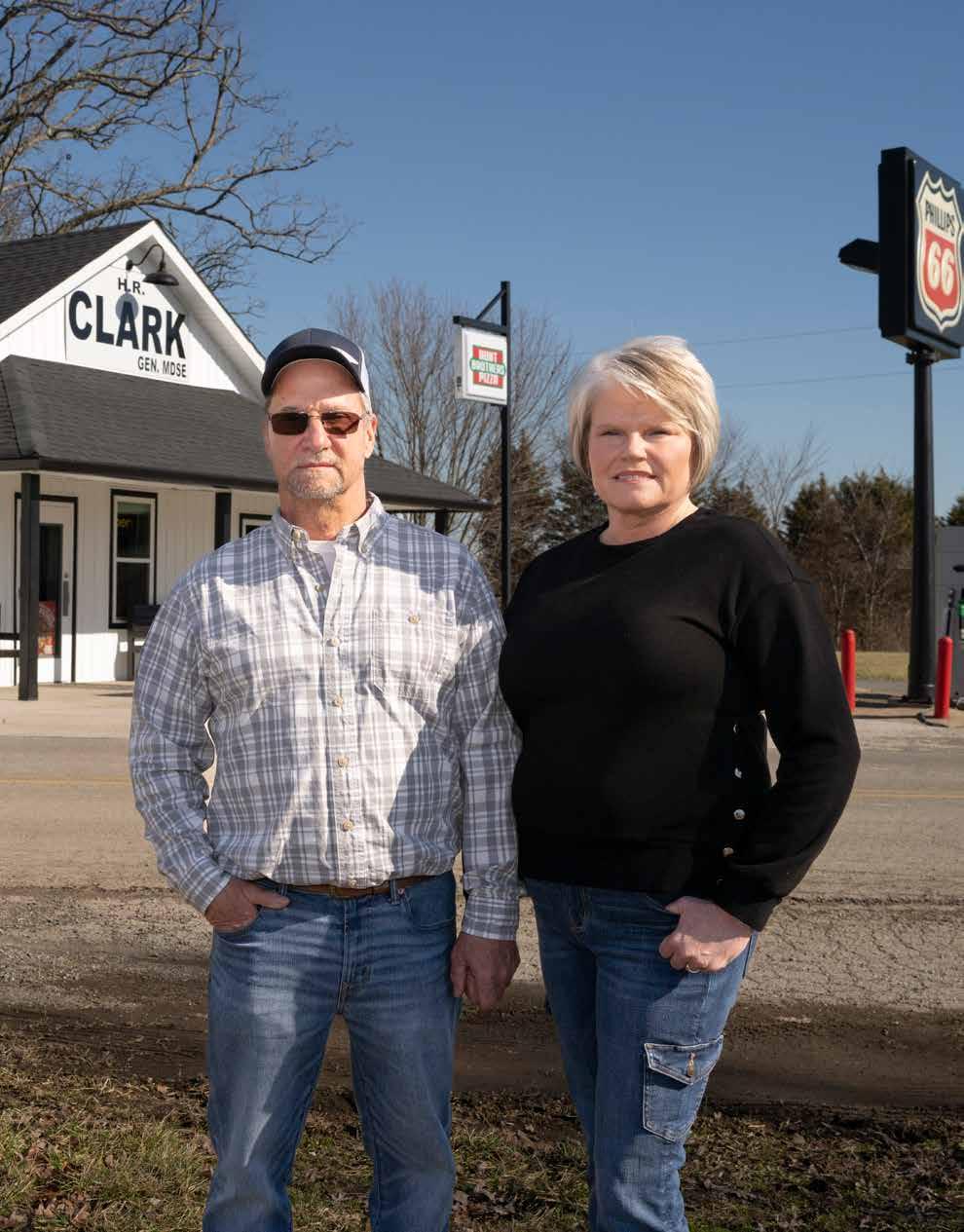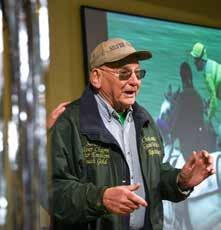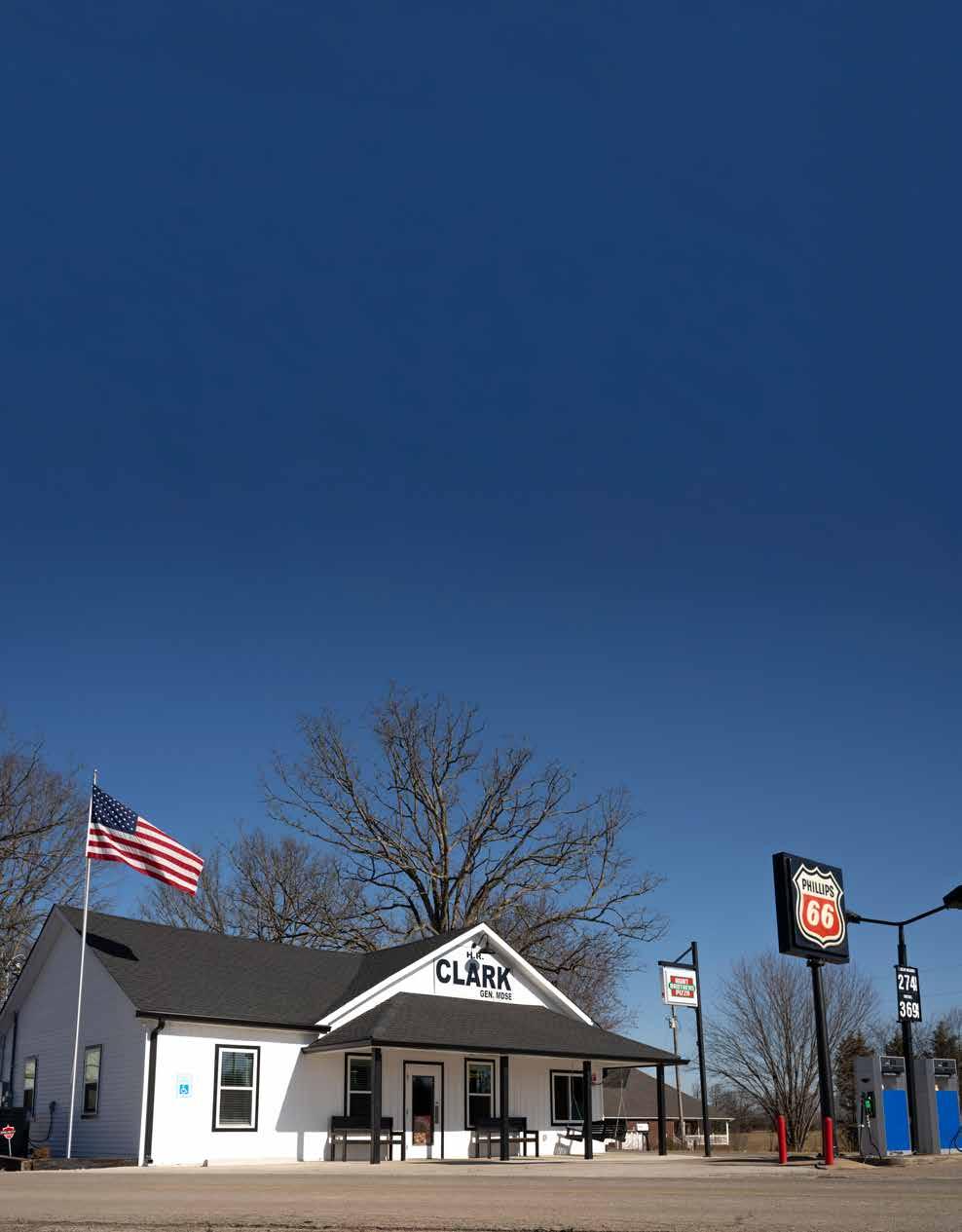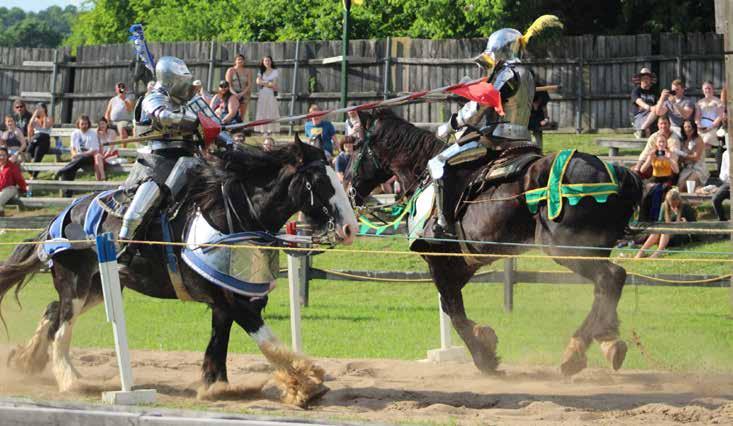Going to market
Local shop gets a new life

SPORT OF KINGS RACEHORSE HAVEN


Local shop gets a new life


through better communications
NTCA proudly represents more than 850 telecommunications companies across rural America as they provide a variety of services including robust broadband, landline, wireless, data, video and IT support. June 1 marks our 70th anniversary, and it’s a perfect opportunity to reflect upon how far this life-changing industry has traveled.
The independent telephone industry began to develop throughout rural America in the 1890s, largely because these regions were ignored by large national providers.
After World War II, as the telephone’s popularity surged and the value of connectivity was recognized, Congress passed legislation to extend loans to bring telephone systems to rural communities.
With funding on the way, the need for an independent national organization to represent small telephone companies was at an all-time high and, in 1954, NTCA was born.
Eight rural telephone systems in seven states became the original members and got to work advocating to grow the industry.
Over the last few decades, NTCA has focused on the evolution of our members from telecommunications to broadband providers as well as numerous key priorities for rural America, including building a sustainable future for universal service, building Smart Rural Communities, providing cybersecurity tools, being the catalyst for policy engagement and so much more.
As NTCA celebrates its platinum anniversary, we are excited to see what is next for this vibrant industry as it supports rural America and beyond.
3
3

Passwords are everywhere. From health care and school to work and play, software, websites, essential services and more, most of our daily online activities require a secure login.
The U.S. Cybersecurity and Infrastructure Security Agency offers three tips to better password security — and a good password follows all three.
1
2
At least 16 characters — longer is stronger!
Option 1: Use a random string of mixedcase letters, numbers and symbols. For example: cXmnZK65rf*&DaaD or Yuc8$RikA34%ZoPPao98t
Option 2: Create a memorable phrase of five to seven unrelated words. Then, get creative with spelling and the addition of a number or symbol.
» Strong: HorsePurpleHatRunBaconShoes
» Stronger: HorsPerpleHatRunBayconShoos
» Strongest: HorsPerpleHat#1RunBayconShoos
Use a different strong password for each account. For example:
» Bank: k8dfh8c@Pfv0gB2
» Email account: LmvF%swVR56s2mW
» Social media account: e246gs%mFs#3tv6
Fortunately, password managers can help you keep up with these longer, more complex codes. Options range from tools already in your web browser to commercial software.

Remote work can be a wonderful opportunity
To those who spend long hours in an office, on the road or in the field, working from home might sound like a dream. And, for some, it is.
It’s estimated that by 2025 about 22% of the U.S. workforce — or 32.6 million people — will work remotely. A 2023 study by Forbes Advisor found 12.7% of the nation’s full-time employees work from home, while another 28% work a hybrid model, dividing the work week between home and the office.
Working from home can help save money on gas, as well as wear and tear on vehicles. The flip side, however, is being face to face with household chores all day. The isolating nature of solo work can also be a challenge, as can establishing the distinction between work and home life.
• It makes sense that fast, reliable internet is the first component to remote work success. If your link to the working world is compromised, you can’t get anything done. A backup location is another must, just in case a storm
knocks out the electricity or your peace and quiet is temporarily disturbed.
• Experts advise setting up a dedicated workspace — not in an area like your living room or bedroom — free from distractions, preferably with a door. While it might be tempting to work from the bed or couch, soft surfaces don’t provide proper support and can lead to headaches, strains and arthritis. It’s also important to consider how your workspace will appear to your co-workers and clients during on-screen meetings.
• Creating a routine is vital for remote work. If your family and neighbors know your schedule, they’ll be less likely to present distractions.
• The opportunities for remote jobs are out there, you just need to know where to look. Computer tech jobs continue to be the most common opportunities, as are marketing, accounting, HR/recruiting and customer service.
When searching for work-from-home opportunities, it’s important to avoid pitfalls. If the job sounds too good to be true, it usually is. Be wary if:
• The ad says things like, “unlimited earning potential,” “investment opportunities and seminars” or “quick money.”
• The job requires upfront expenses from you.
• You’re asked for personal information
— Social Security number, birthdate, banking account numbers, etc. — early in the interview process or as part of your initial application.
• You are offered a job without an interview or anyone contacting or asking for references.
• Better work-life balance
• More freedom
• Improved employee mindset
• Decreased wardrobe budget
• Comforts of home
• No commute, less wear and tear on vehicle
• Self-regulated hours
• Flexible schedule
Are you ready for a vacation? Summer travel season is about to ramp up, and many Americans will be hitting the highway or heading to the airport. Whether it’s a short trip or a multiday excursion, I think about all the ways NCTC’s services can help you plan your perfect break.

Before we chat about how we can help you find your next adventure, however, I’d like you to keep in mind the opportunities our area provides. While we consider this place home, others are discovering that our region is a perfect destination for their own vacations.
That’s the beauty of rural communities like ours. Often there’s so much to do, and it’s easy to take the places you see every day for granted. But our wildlands, trails, parks and more offer great opportunities for outdoor enthusiasts.
Similarly, we have plenty of history shaped by the businesses, industries, people and events that help establish who we are. While you may know the tales of our past, many history buffs and others find these nuggets of days gone by endlessly fascinating.
That’s only the beginning, because there are plenty of interesting places to stay in our area, too. Hotels are a great choice. Also, thanks to internet-based resources, there is a range of vacation rentals with online listings managed by sites like Airbnb and Vrbo.
It’s never been easier to plan a vacation and find our nation’s gems. Have you visited all the local spots? If you’re not sure, I encourage you to venture online. Explore what others say about our region, and you just might find a new adventure right here at home.
But if you’re ready for that summer trip away from home, those same tools come into play. Travel agents very much have a place, and they’re available to help you. But if you have a do-it-yourself mindset, going online opens the door to a wealth of resources.
Many travel sites offer day-by-day itineraries. Are you going to be in a city for two days? A plan is likely available. Considering a weeklong driving trip with some ocean views? Those plans are out there, too — all just a few clicks away.
If you’re wired into social media like Facebook or Reddit, you can tap into another powerful resource — people. Most cities, destinations or hobbies have online groups dedicated to them, and these are often surprisingly helpful. Planning a fishing trip to the coast? Are you a hiker? Or, perhaps you want to explore all the best kid-friendly spots of a specific town or city. There’s an online resource for you. Make no mistake, this type of resource exists for places in our area, too.
Even when we’re contemplating unplugging, the online world can help connect us. We’re proud to provide internet service that allows you to unlock your next adventure.
Thank you for allowing us to serve you.
The North Central Connection is a bimonthly newsletter published by NCTC, © 2024. It is distributed without charge to all member/ owners of the cooperative.

North Central is a member-owned corporation dedicated to delivering advanced telecommunications technology to the people of Northern Middle Tennessee and Southern Kentucky, including Macon County, Tennessee, Allen County and Warren County, Kentucky. NCTC also serves portions of Sumner, Trousdale, Smith and Clay counties in Tennessee.
North Central
872 Highway 52 Bypass East
P.O. Box 70
Lafayette, TN 37083
Telephone: 615-666-2151
www.nctc.com
BOARD OF DIRECTORS
Glen Hardcastle
Chairman of the Board
Scottsville Exchange West
Randy Harston Vice Chairman of the Board
Scottsville Exchange East
Calvin Graves
Secretary of the Board
Bethpage/Oak Grove Exchanges
Martha Bowser
Westmoreland Exchange
Kevin Dickerson
Defeated/Pleasant Shade Exchanges
Donnie Steen
Lafayette Exchange East
Jeff Flippin
Lafayette Exchange West
Chad Evitts
Hillsdale/Green Grove Exchanges
Chad Owens
Red Boiling Springs Exchange
Johnny McClanahan
President/CEO
Guy Holliman
General Counsel
Produced for North Central by:
On the Cover:

Keith and Angela Graves refurbished the old Clark Market near Westmoreland as a way to give back to the community.
See story Page 8.
On Memorial Day, we reflect on the sacrifices that safeguard our freedoms and honor those brave souls who gave their lives serving our nation.


If you receive your home phone service through our state-of-the-art fiber optic network, it requires electric power to operate. To avoid a disruption of home voice service during a power outage — and to maintain the ability to connect to 911 emergency services — a standard corded phone is required. Our battery backups are expected to last eight hours on standby power. That means the backup battery should give you about six hours of talk time. If you feel this is not enough time, you may extend your standby power by purchasing a 24-hour battery or additional eight-hour batteries. Our battery backup does not provide power to any services other than voice. Home security systems, medical monitoring devices, routers and other equipment will not run on a phone backup battery. Unless you are otherwise notified in advance, or in cases of abuse to our equipment, NCTC will maintain the power unit for three years from the date of installation.
In accordance with federal civil rights law and U.S. Department of Agriculture (USDA) Civil Rights regulations and policies, the USDA, its agencies, offices, and employees, and institutions participating in or administering USDA programs are prohibited from discriminating based on race, color, national origin, religion, sex, gender identity (including gender expression), sexual orientation, disability, age, marital status, family/parental status, income derived from a public assistance program, political beliefs, or reprisal or retaliation for prior credible activity, in any program or activity conducted or funded by USDA (not all bases apply to all programs). Remedies and complaint filing deadlines vary by program or incident. Persons with disabilities who require alternative means of communication for program information (e.g. Braille, large print, audiotape, American Sign Language, etc.) should contact the responsible agency or USDA’s TARGET Center at 202-720-2600 (voice and TTY) or contact USDA through the Federal Relay Service at 800-877-8339. Additionally, program information may be made available in languages other than English. To file a program discrimination complaint, complete the USDA Program Discrimination Complaint Form, AD-3027, found online at ascr.usda.gov/ complaint_filing_cust.htmland or any USDA office. Or write a letter addressed to USDA and provide in the letter all of the information requested in the form. To request a copy of the complaint form, call 866-632-9992. Submit your completed form or letter to USDA by: 1) mail: USDA, Office of the Assistant Secretary for Civil Rights, 1400 Independence Ave. SW, Washington, D.C. 20250-9410; 2) fax: 202-690-7442; or 3) email: program. intake@usda.gov. USDA is an equal opportunity provider, employer and lender.
Two former star athletes — fierce rivals in their youth, when they raced neck and neck to world renown — enjoyed the spotlight together recently during an unbridled celebration of their 30th birthdays. There was no sign of the competitive spirit that once drove them. Instead, they displayed the calm that comes with finding greener pastures on the sprawling Kentucky farm where they both live.
Retired racehorses Silver Charm and Touch Gold are the very definition of Old Friends — which is the name of the group that houses them and more than 250 other thoroughbreds. Visitors to Old Friends’ 236-acre Dream Chase Farm in Georgetown, Kentucky, get to meet these majestic retirees. Since its founding in 2003 by Michael Blowen, a former Boston Globe film critic, Old Friends has welcomed about 15,000 visitors for guided tours each year.




• Go to oldfriendsequine.org/visit to schedule a tour.
• Walking tours, 90 minutes:
» General — $30 per person, up to 20 people, no children younger than 10
» Founder’s — $100 per person, up to 15 people, led by Old Friends founder Michael Blowen, no children under 10
» Private — By appointment, $75 per person with volunteer tour guide, $200 per person with Blowen as tour guide, up to 10 people, no charge for children 11 and under
• Driving option, three hours:
» Every Horse on the Farm — $150 per person, up to five people meet all the equine residents of Dream Chase Farm, led by Old Friends photographer Laura Battles, no children
» Buses and groups of more than 10 people, call 502-863-1775 for tour options.
The distance between Louisville’s Churchill Downs and the Thoroughbred Retirement Foundation Sanctuary Farm at Chestnut Hall in Prospect is only 15 miles. But for the thoroughbreds who call the farm home, it’s a very long journey.
This sanctuary and event venue was created in 2021 by the TRF, a national group working to save thoroughbred horses from neglect, abuse and slaughter and providing lifelong sanctuary after their racing days are done. The farm is not open to the public, but tours can be booked through private appointment.
Visit trfinc.org for details about tours and any planned events, like the May Front Porch Summer Concert Series outside the historic Chestnut Hall farmhouse.
Other groups are also hard at work for these animals, rescuing, retraining and rehoming them after their exit from racing. For the past decade, the Thoroughbred Aftercare Alliance has helped fund the efforts of 86 such groups across the United States, including some based in Lexington, Kentucky.
One of those Lexington organizations, New Vocations, has placed more than 8,000 rehabilitated and retrained retired racehorses in adoptive homes since 1992. Another, the all-volunteer CANTER USA, has transitioned more than 25,000 horses. And for 20 years, the thoroughbreds served by the Secretariat Center at Kentucky Horse Park have been placed in new homes and in a range of new jobs, from therapeutic riding programs to mounted police units.
Providing a safe and secure retirement for thoroughbreds past their racing prime is an expensive endeavor, and most organizations doing this kind of work rely heavily, or sometimes exclusively, on donations. Horse sponsorships, monetary gifts, working as a volunteer, shopping at their online stores, fundraiser participation and buying “wish list” items are a few ways to help. Scheduling tours is another way, and it’s the most fun!
ABOVE AND LEFT: Guests meet Touch Gold at the Belmont champion’s 30th birthday party. FAR LEFT: Old Friends founder Michael Blowen addresses guests at the birthday celebration for former rival racehorses Touch Gold and Silver Charm.
When something breaks, Keith Graves’ natural inclination is to fix it. For years, the Westmoreland businessman has restored old cars, buildings and other things. That way, he figures, they can be useful again. “I guess I just like dragging things back out of the woodwork,” he says.
It was the same with Clark Market — an old country store situated at the fork in the road between Bethpage and Westmoreland. For decades, the shop was a staple in the community, but time had taken its toll on the building. “It sat here empty for a long time,” says Keith, who bought the store nearly two years ago with his wife, Angela, a registered nurse. “We just took it back to what it always was — a community store.”
After more than a year of restoration, Clark Market opened in December 2023 with a brand-new look and a community-focused attitude. Like many convenience stores, it sells gas, cold drinks and a few basics, like cat food, brake fluid and some first-aid supplies. The store also serves Hunt Brothers pizza, sausage biscuits, biscuits and gravy, fried bologna sandwiches and more. Karen Shives, Keith’s sister, runs the daily operations and sometimes offers specials, like chicken and dumplings and other home-cooked meals. Troy Alexander cooks breakfast and some short-order items. “We’ve had tacos and pinto beans and turnip greens,” Keith says. “It’s not a big sit-down place, but we’ve got some sitting areas inside and a place out back to sit.”

Freshly made barbecue is also on the menu. Troy, a certified pitmaster from Westmoreland, cooks pork shoulder, pulled pork, brisket, ribs and more on-site, as well as all the sides — baked beans, potato salad, slaw and macaroni and cheese. His homemade barbecue sauce, Killer Bee, includes a touch of honey. A former truck driver, Troy got serious about cooking a few years ago. “I had cooked my whole life ever since I was old enough to look over the stove and help my grandmother,” he says. “I even took home economics in school. I didn’t play football — I took home ec.”
As an adult, he turned to fishing as a pastime. But his wife wasn’t into it. “So, I sold my boat, and I bought a smoker so I could be closer to her during my downtime,” Troy says. He got so into barbecuing that he even got his certification as a pitmaster during a six-week class in California.
When his wife died in 2020, Troy quit his truck driving job and turned to cooking full time, so he could take care of his two young children. “I sell it by the plate or by the pound, however you want it,” Troy says. “I usually do ribs on Fridays. Sometimes I’ll do a ribeye sandwich, too.”
Keith and his family hope to add more amenities to the shop in the future. The overall goal is to make it a place for people to gather, talk and find a friendly face. More than anything, the Graves family wants people to know it’s for everybody.
Keith grew up going to little community stores, and he doesn’t like seeing them disappear. He knows they’re important somehow, and he knows people will show up — especially if they see something they like. When the Graveses reopened the store a few months back, they wanted to start slowly so they could find the kinks

and work them out. Now that’s done, they’re ready to include a few more things here and there to see what works.
“We’re planning to do some things out back, like add a game of horseshoes and things like that,” Keith says. “And growing up, we rode a lot of horses and stuff. There are still some garrisons that have still got mules and wagons. They’ve requested a hitching post, so we’ll probably put one of those in.”
Clark Market uses NCTC’s high-speed fiber internet to manage credit card transactions, but the cards’ transaction fees are not passed on to the customer. “We take it on,” Keith says. “We’re not doing any of this for the money. I’m 60, and I’ll never live to get back all the money I put into it. But if I can draw these people that work here a paycheck, and then have something that’s good for the community? It’s going to mean the world to me.”
Clark Market is an old-time country convenience store situated at the crossroads of Westmoreland and Bethpage, Tennessee. The address is 1001 Dutch Creek Road, Westmoreland. Visit today to get freshly made barbecue by the plate or by the pound, breakfast biscuits, deli sandwiches and much more.


As a child growing up in California, Kim McCourt scrambled up hills, cliffs and trees to see the land below. “I had this need to see all those things I never even knew were there,” he says.
But when his family moved to the flatlands of Florida, he had to find a new way to see the world. In 1998, he took his first flight in a hot air balloon. “I learned that ballooning is, well, kind of magical,” says Kim, who is now a licensed hot air balloon pilot in the Orlando region. “There’s the exploration part of it, and you’ve got Mother Nature all around you.”
These days, Kim often travels the skies with tourists who want to experience a ride they can’t find at the region’s theme parks. For many, it’s a way to fly without being contained in the metal tube of an airplane. “In the balloon, you can see so much more, and you can actually feel everything,” Kim says. “You can breathe the air.”
There’s a spiritual component, too, says Mark West, vice president of the Balloon Federation of America. West, a former Navy pilot, also served as president and chief engineer of Aerostar International, which was once the largest hot air balloon manufacturer in the country.
“Ballooning has an incredible amount of magic to it,” Mark says. “Virtually everyone who sees one is enamored with them. I suppose they’re kind of representative of breaking free of the bonds of Earth and floating away.”
Across the country, hot air balloon rides are a popular pastime for families celebrating a special occasion or tourists looking for a new experience. Some passengers want to make memories with their families, while others go to commemorate important events, like marriage proposals, bucket lists and to spread the ashes of loved ones into the sky. “There are all kinds of stories,” Kim says. “The only things that stay the same are the sun coming up and people smiling.”

CLOCKWISE FROM LEFT: Balloons get ready for a flight.
Most hot air balloons are operated by gas.
Hot air balloons take off during an event.


But as wide-open spaces dwindle, so do the balloon rides. Pilots simply don’t have enough space to land. Weather’s also been a factor, because unreliable winds can ground a pilot. Kim says he’s seen this firsthand. “Over the last 15 years, the weather went from 275 days we could fly to probably 100 days,” he says.
He worries other factors could cause ballooning to take a hit, too. “Fabric, wicker, propane, repairs and parts are way more expensive these days, so it takes more money to maintain them,” Kim says.
Despite the challenges, Kim still grins like a kid after an early-morning
flight. “There’s nothing like it,” he says. “When we lift off and the sun starts to rise, we might rest at the top of a tree and stare clear down to the bottom of a pond. Then we’ll take off again and maybe rest right on top of the water where the mist is coming off the surface. It’s up and down, up and down — gently. One person said it was like flying in the hand of God while getting a brain massage.”
Balloonists enjoy attempting to describe the sensation of floating on — and with — the air, Mark says. “One of my good friends said it was ‘having a destiny without a destination.’ I think it attracts people who want to enjoy the beauty of the Earth and want to experience that kind of freedom.”
To catch a ride with Kim McCourt, visit greaterorlandoballoonrides.com. For more information on hot air ballooning and the people who are passionate about it, visit the Balloon Federation of America’s Facebook page, or find the group at bfa.net

June 1783 — First unmanned flight
After a year or two of experimentation and invention, brothers Joseph Michel and Jacques Etienne Montgolfier publicly launch their version of a hot air balloon. It held no passengers. The balloon landed in the middle of a vineyard a little over a mile from where it had taken off.
September 1783 — Confused farm animals
The first balloon flight with passengers launches in Versailles carrying a duck, a rooster and a sheep. The animals made it out alive. However, sources say the sheep kicked the duck and damaged its wing. King Louis XVI of France was pleased to learn that animals could breathe so high up.
November 1783 — First human flight
Jean-François Pilâtre de Rozier and another passenger take the first untethered, humanoccupied flight. The flight, which launched in France, lasted about 25 minutes and reached an altitude of about 500 feet. Less than two years later, de Rozier and his passenger would become the first people to die in a hot air balloon crash during a flight from France to England.
December 1783 — Hydrogen balloon
Jacques Charles, a French physicist who had been experimenting with hydrogen balloons, boards one with a few colleagues. They traveled 25 miles in less than two hours. They also carried a barometer and a thermometer. Afterward, gas balloons became the preferred method of ballooning.
Photos by Kim McCourt


As the Singing Scotsman, Sir Ian McFarland has crossed swords and lances with people from all over the world. He has traveled in time to the world of King Henry VIII, while racing on horseback toward an 11-foot wooden lance aimed at his body.
But underneath the armored plates, pageantry and St. Andrew’s Cross, Sir Ian is actually Gene Martino Jr., a United Methodist minister with a passion for the centuries-old sport of jousting. “It’s unusual, and we all know that, but I’ve always been a little weird,” says the 65-yearold Westmoreland man.
Gene moved to the town and joined the region’s jousting troop, The Free Lancers, after a chance meeting during a Texas Renaissance fair almost 15 years ago. “I was helping a guy fix something, and a couple weeks later I found myself being thrown on a horse,” Gene says. “I’d never ridden a horse before.”
That “guy” — world-renowned jouster and Westmoreland resident Roy Cox — put Gene through a two-week crash course in the sport of kings. The next thing he knew, Gene was wearing armor and competing at an event in Canada. It wasn’t long before he and his wife, Becky, left Texas for a 50-acre plot near the Kentucky line — the perfect place to call home and keep horses for his newfound passion.
Jousting got its start in the Middle Ages as a military tactic in the cavalry. From there, it evolved into a way for knights to train for battle or simply show off their skills. During a duel, riders on horseback run toward each other carrying wooden lances they use to try to knock the other off the horse. The sport was a favorite of King Henry VIII, who, before gaining notoriety for executing his wives, was known for his athletic prowess and competitive nature.
These days, jousting enthusiasts like Gene compete in tournaments to win prizes or entertain crowds at Renaissance festivals. Points are based on hitting shields and the quality of each pass rather than true combat. But it’s still difficult, and it’s still dangerous, says Gene, who has won two national tournaments, three East Coast tournaments and placed sixth in an international competition.
His troop, The Free Lancers, got its name from a term for independent knights without an obligation to fight for an overlord. The knights formed their own companies and leased their services. “That’s where we get the word ‘freelancer’ from today,” Gene says.


 Photo by Neil Rothschild
Photo contributed by Gene Martino
Photo by Neil Rothschild
Photo contributed by Gene Martino


Jousting as a sport has changed little over the centuries, even as cultures have changed dramatically. “We use all the same rules, all the same regulations — just how they would do it back then,” he says. “We even use the same armor, the same kinds of horses. It’s something that’s really hard to do, and not many people can do it. I refer to it sometimes as ‘target shooting on horseback with a stick.’”
The jousting community is relatively small but close-knit, says Gene, who keeps in touch with friends all over the world via Facebook groups and other social sites. “I may not have talked to someone for a while, but I’ll keep up with their news,” he says. “I’ll get in touch if they lose a horse or get hurt. We sometimes raise funds for each other or just support each other.”
ABOVE: Gene Martino, left, faces off against another competitor during a joust.
LEFT: Gene, left, salutes during an event.
While he loves the pageantry and the history of the sport, the horse is what makes jousting truly compelling for Gene. “It’s about the partnership between the rider and the horse,” he says.
Preparing horses for jousting requires the rider to develop trust with the animal through daily training. “Horses are a herd animal,” he says. “And they’re not predators. But here you are trying to teach these creatures to run toward each other while they’ve got these heavy weights on their backs that are making a lot of noise. And, oh by the way, the person coming towards you is carrying a multicolored flag and trying to take your rider off.”
When the horse and rider learn to work in sync, the experience is thrilling. “I’ve had a rare part nership with these equines,” Gene says. “It gets to where I don’t have to tell them what to do. They know what you’re thinking, and you know what they’re thinking. You do everything as a team. It almost seems telepathic.
“It’s an expansive thing and a relationship thing — the horse and the rider and the relationship and trust we have is what’s important,” he adds. “We literally have each other’s lives in our hands every time we go down that list.”




Although we love creating new recipes in keeping with today’s tastes and trends, there’s something sweet about a vintage recipe that can still hold its own. Get ready for a trip down memory lane with these old-fashioned recipes we still love.
From classic chicken tetrazzini to a delightful lemon icebox pie, these vintage recipes are worth holding onto. They may have been gone from our culinary repertoire for a decade or two, but they certainly are not forgotten.
Ready for some nostalgia and satisfied smiles at your table?
Give these retro recipes a try, and they’re sure to stir up good memories.

Food Editor
Anne P. Braly is a native of Chattanooga, Tennessee.

No roundup of retro recipes is complete without a classic chicken tetrazzini.
16 ounces linguini or spaghetti, cooked
1/2 cup unsalted butter, softened
4 chicken breasts, cooked and diced
2 cans cream of chicken soup
2 cups sour cream
1 teaspoon garlic salt
1 tablespoon chopped parsley
1/2 teaspoon pepper
1 cup chicken broth
2 tablespoons Parmesan cheese, grated
2 cups mozzarella cheese shredded
Preheat the oven to 350 F. Grease a 9-by-13-inch baking dish and set aside.
Cook noodles to al dente, according to the box instructions. Drain and set aside. Meanwhile, in a large bowl, combine chicken, soup, sour cream, butter, chicken broth, garlic salt, parsley and pepper. Mix well, then stir in cooked noodles. Pour mixture into prepared baking dish. Sprinkle both cheeses on top and bake, uncovered, for 36-42 minutes, until cheeses are melted and casserole is bubbling.
Photography by Mark Gilliland Food Styling by Rhonda GillilandIf you can’t wait until summer to take advantage of sweet Silver Queen corn, use the sweetest corn you can find.
13 ears of fresh corn, husks and silks removed
1 cup evaporated milk
1 tablespoon unsalted butter
1/2 teaspoon salt
1/8 teaspoon pepper
Remove silks from corn. Cream the corn by cutting the kernels from the cobs, then scrape the
corn cobs with the back of the knife to get all the “milk” and pulp. Transfer creamed corn to a large skillet. Add milk, butter and salt. Cook over low heat, stirring often, for 30 minutes. If corn becomes too thick, add more milk for desired consistency. Sprinkle with pepper. Makes 6-8 servings.

1 skillet of your favorite cornbread
1 cup diced onions
1 green or red bell pepper, seeded and diced
1 cup diced tomato
1 15-ounce can whole kernel corn, drained
1 pound bacon, cooked until crisp and crumbled
2-3 cups mayonnaise
1 package ranch dressing mix
Crumble cooled cornbread into a large bowl. Add onions, bell pepper, diced tomatoes, corn and bacon. Stir until well combined. In a separate bowl, stir together mayonnaise and ranch mix until wellblended. Add mayonnaise dressing mixture to salad and stir until fully mixed. Cover and refrigerate at least 2 hours before serving.

Finish your retro meal with a slice of this much-loved pie.
Crust:
1 1/2 cups graham cracker crumbs
2 tablespoons granulated sugar
7 tablespoons butter, melted
Filling:
2 14-ounce cans sweetened condensed milk
1 cup fresh lemon juice
5 large egg yolks
1 tablespoon lemon zest
1 cup heavy cream
2 tablespoons powdered sugar
1/2 teaspoon vanilla extract
For the crust: Preheat the oven to 350 F. Combine the cracker crumbs, sugar and butter in a medium bowl. Mix with a fork until the crumbs are well coated and stick together when pinched. Press the mixture into the bottom and up the sides of a 9-inch pie plate. Bake until set, about 10 minutes. Set aside to cool slightly, about 10 minutes.
For the filling: Whisk together the condensed milk, lemon juice, egg yolks and lemon zest in a medium bowl until combined. Pour the filling into the crust and bake until the center is set but still slightly jiggly, about 15 minutes. Let cool for 30 minutes, then refrigerate until chilled, about 2 hours.
Once pie is chilled, beat the heavy cream, powdered sugar and vanilla in a large bowl with a mixer on medium speed until soft peaks form. Spoon onto the center of the pie and serve. Alternatively: Buy a premade graham cracker crust as a timesaver.
